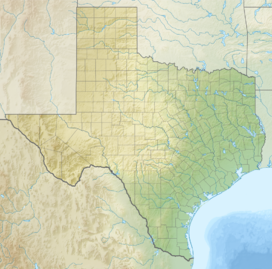Burro Mesa: Difference between revisions
Ron Clausen (talk | contribs) →External links: wikilink |
Ron Clausen (talk | contribs) add photo/gallery |
||
| Line 45: | Line 45: | ||
*[[Geography of Texas]] |
*[[Geography of Texas]] |
||
*[[Burro Mesa Archeological District]] |
*[[Burro Mesa Archeological District]] |
||
| ⚫ | |||
==Gallery== |
|||
<div style="max-width: 490px;"> |
|||
<gallery mode=slideshow> |
|||
File:Burro Mesa, Big Bend National Park, TX.jpg|Southeast aspect |
|||
| ⚫ | |||
</gallery> |
|||
</div> |
|||
==References== |
==References== |
||
Revision as of 03:07, 22 November 2024
| Burro Mesa | |
|---|---|
 Southwest aspect | |
| Highest point | |
| Elevation | 4,434 ft (1,351 m)[1] |
| Prominence | 562 ft (171 m)[1] |
| Isolation | 3.37 mi (5.42 km)[2] |
| Coordinates | 29°14′50″N 103°24′45″W / 29.2471772°N 103.4126099°W[3] |
| Dimensions | |
| Length | 5 mi (8.0 km) North-South |
| Width | 4 mi (6.4 km) East-West |
| Naming | |
| Etymology | Burro |
| Geography | |
| Country | United States |
| State | Texas |
| County | Brewster |
| Protected area | Big Bend National Park[1] |
| Parent range | Chisos Mountains[1] |
| Topo map | USGS Cerro Castellan |
| Geology | |
| Rock age | Oligocene |
| Mountain type | Mesa |
| Rock type | Igneous rock |
| Climbing | |
| Easiest route | class 2 hiking[2] |
Burro Mesa is a 4,434-foot-elevation (1,351-meter) summit in Brewster County, Texas, United States.
Description
Burro Mesa is part of the Chisos Mountains where it is set in Big Bend National Park and the Chihuahuan Desert. Based on the Köppen climate classification, the mesa is located in a hot arid climate zone with hot summers and mild winters.[4] This climate supports shrubland plants on the slopes such as lechuguilla, creosote bush, ocotillo, and cacti.[5] Any scant precipitation runoff from the slopes drains to the Rio Grande via Alamo, Cottonwood, and Terlingua Creeks. Topographic relief is modest as the summit rises 1,200 feet (366 m) above Javelina Wash in one mile (1.6 km). The mountain's toponym has been officially adopted by the United States Board on Geographic Names and it is so named for the herds of wild burros which once roamed here.[3]
Geology
The mesa is composed of Quaternary sediments overlaying 29-million-year-old Oligocene Burro Mesa Formation which includes Burro Mesa Rhyolite overlaying Wasp Spring Tuff. The volcanic rocks exposed at the south end of the mesa include rhyolite, tuff, Bee Mountain Basalt and conglomerate of the Chisos Formation.[6][7] The Burro Mesa fault is exposed on the northeast flank of Burro Mesa, forming one of the notable faults in this area of the park.[5]
See also
Gallery
References
- ^ a b c d "Burro Mesa, Texas". Peakbagger.com. Retrieved 2024-11-12.
- ^ a b "Burro Mesa - 4,431' TX". listsofjohn.com. Retrieved 2024-11-12.
- ^ a b "Burro Mesa". Geographic Names Information System. United States Geological Survey, United States Department of the Interior. Retrieved 2024-11-12.
- ^ Peel, M. C.; Finlayson, B. L.; McMahon, T. A. (2007). "Updated world map of the Köppen−Geiger climate classification". Hydrol. Earth Syst. Sci. 11. ISSN 1027-5606.
- ^ a b Burro Mesa, Texas State Historical Association, Retrieved 2024-11-12.
- ^ Gray, J.E., Geological, Geochemical, and Geophysical Studies by the U.S. Geological Survey in Big Bend National Park, Texas, U.S. Geological Survey Circular 1327, p. 31, Retrieved 2024-11-12.
- ^ High And Dry: The Burro Mesa Pouroff, Francis Redfern, Retrieved 2024-11-12.
External links
- Burro Mesa: Weather



